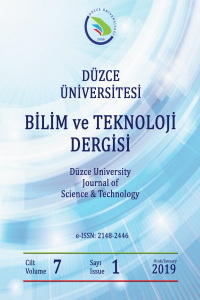Abstract
The rapid annual
increase in air traffic volume leads to serious capacity problems especially at
major airports. Airport runway capacities are significantly limited by wake
turbulence phenomena between arriving and departing aircraft pairs. RECAT, an
international joint effort, aims to redefine wake turbulence categories and
their associated minima to increase runway capacities. This study analyses the
impacts of possible RECAT implementation on arriving and departing flight sequences
for independent parallel runway configurations with saturated demand. Istanbul
New Airport is modelled as a test case using Simmod Pro, a discrete-event
simulation tool. A baseline and an alternative scenario has been created to
compare the current and RECAT separation minima. The implementation of RECAT
improved the total throughput and reduced airborne delays for arriving flights
while it increased departure queue delays and lengths. Further operational
strategies are required to increase the benefits of RECAT for departing flight
sequences.
References
- [1] Eurocontrol, “Network Operation Report 2017”, Bruxelles, Belgium.
- [2] Airbus, “The Market Long and Short-term Outlook”, Airbus, 2016.
- [3] Eurocontrol, “European Wake Turbulence Categorisation and Separation Minima on Approach and Departure RECAT-EU”, Eurocontrol, Bruxelles, 2015.
- [4] Eurocontrol, “Coverage of 2013 European Air Traffic for the Base of Aircraft Data (BADA)-Versions BADA 3.12 and BADA 4.1, ECC Technical/Scientific Report” No. 14/11/13-54, Bruxelles,Belgium, 2014.
- [5] S. Lang, J. Tittsworth, W.H. Bryant, P. Wilson, C. Lepadatu, D.P. Delisi, D.Y. Lai, G.C.Greene, “Progress on an ICAO Wake Turbulence Re-Categorization Effort”, AIAA Atmospheric and Space Environments Conference, Toronto, Canada, 2010.
- [6] International Civil Aviation Organisation (ICAO), “Procedures for Air Navigation ServicesAir Traffic Management”, PANS-ATM, DOC 4444, Canada, 2016.
- [7] F. Roseeler, V. Treve, I. De Visscher, R. Graham, “Wake Turbulence Re-categorisation on Approach and Departure for Safe and More Efficient Air Traffic Management”, 30th Congress of the International Council of the Aeronautical Sciences, Dajeon, Korea 2016.
- [8] J. Cheng, J. Tittsworth, W. Gallo, A. Awwad, “The Development of Wake Turbulence Recategorization in the United States”, AIAA Atmospheric and Space Environments Conference, Toronto, Canada, 2016.
- [9] IGA [Online]., (2018, 5 September). Available: http://www.igairport.com/tr/igahakkinda/insaat/asamalar.
RECAT Uygulamasının İstanbul Yeni Havalimanı Hava Trafik Akış Yönetimine Olan Etkisinin Kesikli Olay Benzetimi ile Analizi
Abstract
Hava trafik hacmindeki hızlı yıllık artış, özellikle büyük havaalanlarında ciddi kapasite sorunlarına yol
açmaktadır. Havaalanı pist kapasitesinde geliş ve kalkış uçakları arasındaki kuyruk türbülansı farklılıkları önemli
ölçüde sınırlayıcıdır. Bu konuya odaklanmış uluslararası bir ortak çaba olan RECAT, pist kapasitesini artırmak
için kuyruk türbülans kategorilerini ve bunlarla ilişkili ayırma minimalarını yeniden tanımlamayı
amaçlamaktadır. Bu çalışmanın amacı, yüksek talebe sahip bağımsız paralel pist konfigürasyonları için olası
RECAT uygulamasının geliş ve kalış uçuşları üzerindeki etkisini analiz etmektedir. İstanbul Yeni Havalimanı
için bir kesikli olay benzetim aracı olan Simmod Pro ile bu konuya örnek olabilecek bir model geliştirilmiştir.
Mevcut ve RECAT ayırma minimini karşılaştırmak için bir mevcut durum ve alternatif olmak üzere iki senaryo
oluşturulmuştur. RECAT'ın uygulanması, kalkış uçuşlarındaki gecikmeleri ve uzunlukları artırırken, gelen uçuşların toplam verimini ve havadaki gecikmelerini azaltmıştır. Kalkış uçuşlarında RECAT'in faydalarını
arttırmak için ilave operasyonel stratejiler gereklidir.
References
- [1] Eurocontrol, “Network Operation Report 2017”, Bruxelles, Belgium.
- [2] Airbus, “The Market Long and Short-term Outlook”, Airbus, 2016.
- [3] Eurocontrol, “European Wake Turbulence Categorisation and Separation Minima on Approach and Departure RECAT-EU”, Eurocontrol, Bruxelles, 2015.
- [4] Eurocontrol, “Coverage of 2013 European Air Traffic for the Base of Aircraft Data (BADA)-Versions BADA 3.12 and BADA 4.1, ECC Technical/Scientific Report” No. 14/11/13-54, Bruxelles,Belgium, 2014.
- [5] S. Lang, J. Tittsworth, W.H. Bryant, P. Wilson, C. Lepadatu, D.P. Delisi, D.Y. Lai, G.C.Greene, “Progress on an ICAO Wake Turbulence Re-Categorization Effort”, AIAA Atmospheric and Space Environments Conference, Toronto, Canada, 2010.
- [6] International Civil Aviation Organisation (ICAO), “Procedures for Air Navigation ServicesAir Traffic Management”, PANS-ATM, DOC 4444, Canada, 2016.
- [7] F. Roseeler, V. Treve, I. De Visscher, R. Graham, “Wake Turbulence Re-categorisation on Approach and Departure for Safe and More Efficient Air Traffic Management”, 30th Congress of the International Council of the Aeronautical Sciences, Dajeon, Korea 2016.
- [8] J. Cheng, J. Tittsworth, W. Gallo, A. Awwad, “The Development of Wake Turbulence Recategorization in the United States”, AIAA Atmospheric and Space Environments Conference, Toronto, Canada, 2016.
- [9] IGA [Online]., (2018, 5 September). Available: http://www.igairport.com/tr/igahakkinda/insaat/asamalar.
Details
| Primary Language | English |
|---|---|
| Subjects | Engineering |
| Journal Section | Articles |
| Authors | |
| Publication Date | January 31, 2019 |
| Published in Issue | Year 2019 Volume: 7 Issue: 1 |


